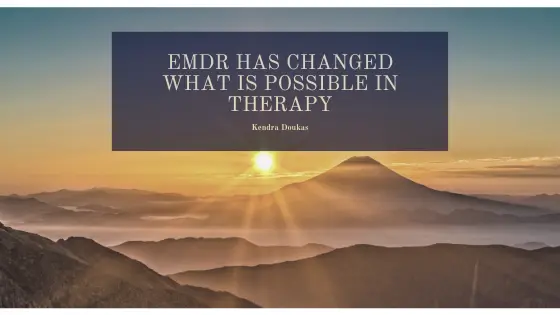Trauma has always been a focus of my clinical work and I dealt with it long before I received training in Eye Movement Desensitization and Reprocessing (EMDR) therapy. Prior to having training in EMDR, I found trauma work to be challenging and slow. It was as if my clients cognitively knew what they needed to heal, but just could not get their bodies and brains to feel it or to release the negative messages they were holding. One of the reasons for this is that experiencing trauma literally changes our brains. Most people who have experienced trauma know that the stuck thoughts they are experiencing are irrational or extreme, yet still they hold onto them.
Most of us can relate to the feeling of knowing something to be true in our minds but not trusting it in our hearts. I have found that EMDR heals this disconnect between the heart and the head and allows clients to fully recognize their healing in a way that talk therapy simply cannot accomplish. Trauma memories are often stored in the right hemisphere of the brain. Talk therapy accesses many tools in the left-hemisphere. Therefore I believe that a lot of the processing just cannot compute in traditional talk methods. I find it interesting that the successful pieces of many talk therapy methods are those parts that include things like metaphor and re-storying and other things that engage more of that right-hemisphere or whole brain thinking.
EMDR allows many people to graduate from therapy who would otherwise be very long-term clients
Adding EMDR to my trauma treatment toolkit allowed me to start graduating people from long-term therapy. Many clients that seek me out due to the fact they are relocating to the Denver area and are looking for their new long-term therapist. Many of these clients have a trauma history and they have grown to learn that regular therapy will be a cornerstone of managing their mental health. One of the best parts of my job is telling these folks about EMDR and holding out hope for them to graduate from routine therapy. Time and time again I have had the privilege of watching clients graduate from needing any kind of regular therapy after completing their EMDR treatment.
It is such an honor to get to witness the journey of EMDR with my clients and to see my clients’ brains shifting the way they need to. It also validates the very idea of what I believe is at the root of change: A healthy, trusting, securely-attached relationship between two people. I find it such a beautiful and powerful idea that the true potential for healing lies in the very most foundational thing in our world: Connection. Certainly, relationships are not easy, but the idea that a true connection between two people is what sets the stage for healing is quite parsimonious.
EMDR works because it allows the brain to heal and reorganize in its own, preferred way of functioning
EMDR works because it allows the brain to heal and reorganize information in the very way the person’s system would have wanted to do in the first place had it not been caught up in a flight/flight/freeze stress response. In EMDR the client’s brain guides the work. My job is to set the stage, to be a safe, non-judgmental space, and to hold confidence and hope. Once I set the stage correctly, I find the client’s brain will just go where it needs to and I will stay in the space of guiding it and encouraging the work- without my own agenda and without any time pressure. I work hard to bear witness and facilitate the change.
I was trained in EMDR nearly a decade ago after having many mentors speak of its “magic”. And even to this day, it really does seem to be magic at times. I, of course, understand the science behind why it works, but it works so well that my clients, many of whom are in the mental health field themselves, joke about how “crazy” EMDR is. I have the experience several times each week where a client is so overwhelmed by how “crazy” EMDR is and how well it works that they have to break from the actual reprocessing to just admire or be baffled by the process.
EMDR is Messy:
EMDR is messy. I often use the metaphor of EMDR treatment feeling a bit like getting out your holiday decorations to find a box of lights all jumbled up and half working. Most of the trauma I see is quite chronic and complex. My clients and I lay out a plan for tackling all of the targets of the trauma, which is a little bit like seeing which light bulbs need replaced and which strands are caught up on other strands. Eventually we find the culprit light and the whole sting lights up instantly. The light strings also take some untangling—The brain has done the best it can but now we have to work to carefully untangle it. We do that by understanding it, exploring it, and playing a mix between engineer and detective. During the EMDR process my clients commonly feel a bit confused about what the specific target is we are working toward because often the many targets are linked together like the light string. It is my job to keep navigating and keep track of the plan so that my clients can just lean into the process of EMDR. If you have ever had the experience of untangling a string of lights, you have likely seen how something can go from an absolute mess, to the point in the process where you believe you might never sort out the string, to then all of the sudden the strand of lights lying perfectly flat on the floor, unwound and ready to shine. I find we often have to work on many of the targets simultaneously but then we figure out that turn or twist of the string and the lights magically fall into place and the trauma is worked through.







